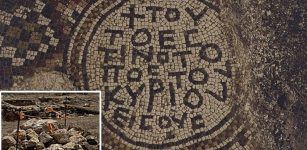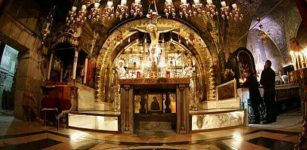1,500-Year-Old ‘Magical Mirror’ To Protect Against Evil Eye Discovered By A Teenager In Israel
Jan Bartek - AncientPages.com - Many ancient cultures used so-called 'magical mirrors' to ward off evil forces. The belief in the power of the Evil Eye goes thousands of years back in time.
As previously discussed on Ancient Pages, the curse of the Evil Eye is an ancient, superstitious, and almost universal belief that certain people possess the supernatural power to cause disaster, illness, calamity, and even death.
Aviv Weizman presenting the mirror fragment she found. Photo credit: Emil Eljam, Antiquities Authority
They have the ability to do it with a gaze or stare that gives an unpleasant emotion. Millions in many parts of the world still fear the evil eye.
Archaeologists have found many ancient artifacts showing how our ancestors tried to protect themselves against the Evil Eye.
As part of a "Survival Course" run by the Shelah branch in the Ministry of Education, 500 high-school pupils participated in archaeological excavations around the country together with the Israel Antiquities Authority.
One of the students was Aviv Weizman, 17, who suddenly spotted a mysterious ancient when the team excavated an area in Usha, near Kiryat Ata, a city in Israel's Haifa District. Aviv noticed an unusual pottery sherd that peeped out of the ground between the walls of a building. Aviv uncovered the sherd, picked it up, and showed it to Dr. Einat Ambar-Armon, Director of the Israel Antiquities Authority Northern Education Center, who recognized the find as the plaque of a magical mirror.
Experts have now confirmed the teenage girl uncovered an exceptional find from the Byzantine period - a 1,500-year-old “magical mirror.”
"The fragment is part of a “magical mirror” from the Byzantine period, the 4th–6th centuries CE. A glass mirror, for protection against the Evil Eye, was placed in the middle of the plaque: the idea was that the evil spirit, such as a demon, who looked in the mirror, would see his own reflection, and this would protect the owner of the mirror.
Similar mirror plaques have been found in the past as funerary gifts in tombs, to protect the deceased in their journey to the world to come," Navit Popovitch, Israel Antiquities Authority Curator of the classical Period said in a press statement.
An almost complete mirror plate used as a demonstration. Previously found in a Nitsana excavation. Photo credit: Clara Amit, Israel Antiquities Authority
The Byzantine period marks a time when the Roman Empire continued across the East after it fell in the West. It continued to exist in the East until the empire's capital, Constantinople, fell in 1453.
The magical mirror allows archaeologists to gain more insight into this period, as well as the superstitious beliefs of people living in the region.
The mirror fragment was probably used for magic. Photo credit: by Emil Eljam, Israel Antiquities Authority
"During the week-long trek, the young leaders discovered additional finds, including pottery jars, coins, decorated stone fragments, and even a water aqueduct. History, usually taught in the classroom, comes to life from the ground. A pupil who uncovers a find during an excavation will never forget the experience. There is no better way to attach the youth to the country and the heritage," Eli Escusido, Director of the Israel Antiquities Authority, told the press.
See also: More Archaeology News
"This find embellishes the two-way contribution of the cooperation between the Israel Antiquities Authority and the Ministry of Education Shelah Project: at the same time, uncovering the country's past and also providing the youth with a personal empowering experience, connecting them to their roots," Saar Ganor, coordinator of the project on behalf of the Israel Antiquities Authority, said.
Written by Jan Bartek – AncientPages.com Staff























